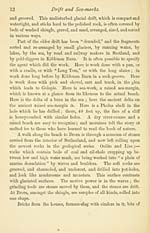Download files
Complete book:
Individual page:
Thumbnail gallery: Grid view | List view

Drift — Stones. 11
end of this glacier in smooth slippery grooves. But as the whole
mass of ice is moving, the whole load upon it — the stones and
rivulets, slippery grooves and all — are slowly moved in the same
direction. The stones make " drift," and each process gives a
different kind-
Stones which are under the ice are pushed by it, and they are
ground and grooved upon the rock beneath.
Stones which rest upon the ice where they fell are carried down
as safely as on a sledge, and reach the end of the glacier with sharp
angles, as they fell when they were quarried. Stones like these
are piled at the foot of every Scotch cliff as scaurs or cairns.
Stones which get into watercourses on the ice are there rolled,
knocked together, and tumbled about, as they are in any other
watercourse, and they take the shape of water-worn shingle. These
are finally shot out at the end of the ice-burns, and then they form
conical piles about the lower end of the glacier {see woodcut, p. 8).
Stones which get into watercourses under the ice are rolled
in tunnels under an arch of ice, over a hollow of stone, which
differs in no way from hollows exposed to the sky elsewhere {see
p. 8).
Glacier drift, then, consists of stones, and sand, and mud, and
gravel, which have all been subjected to certain mechanical treat-
ment, and which have all moved down hill from their source
towards the sea.
A practised eye can easily track old glaciers by drift, as well as
by ruts.
Drift in North America, in Scandinavia, and Northern Europe
generally, in the British Isles, in Scotland, and in Sutherland in
particular, consists of clay of various colours ; in which large
boulders, smaller angular stones, and sand, are tightly packed,
without reference to size, shape, or weight. This drift, which,
amounts to a small geological formation, generally rests upon solid
rock, whose surface, when newly uncovered, is beautifully smoothed
end of this glacier in smooth slippery grooves. But as the whole
mass of ice is moving, the whole load upon it — the stones and
rivulets, slippery grooves and all — are slowly moved in the same
direction. The stones make " drift," and each process gives a
different kind-
Stones which are under the ice are pushed by it, and they are
ground and grooved upon the rock beneath.
Stones which rest upon the ice where they fell are carried down
as safely as on a sledge, and reach the end of the glacier with sharp
angles, as they fell when they were quarried. Stones like these
are piled at the foot of every Scotch cliff as scaurs or cairns.
Stones which get into watercourses on the ice are there rolled,
knocked together, and tumbled about, as they are in any other
watercourse, and they take the shape of water-worn shingle. These
are finally shot out at the end of the ice-burns, and then they form
conical piles about the lower end of the glacier {see woodcut, p. 8).
Stones which get into watercourses under the ice are rolled
in tunnels under an arch of ice, over a hollow of stone, which
differs in no way from hollows exposed to the sky elsewhere {see
p. 8).
Glacier drift, then, consists of stones, and sand, and mud, and
gravel, which have all been subjected to certain mechanical treat-
ment, and which have all moved down hill from their source
towards the sea.
A practised eye can easily track old glaciers by drift, as well as
by ruts.
Drift in North America, in Scandinavia, and Northern Europe
generally, in the British Isles, in Scotland, and in Sutherland in
particular, consists of clay of various colours ; in which large
boulders, smaller angular stones, and sand, are tightly packed,
without reference to size, shape, or weight. This drift, which,
amounts to a small geological formation, generally rests upon solid
rock, whose surface, when newly uncovered, is beautifully smoothed
Set display mode to: Large image | Transcription
Images and transcriptions on this page, including medium image downloads, may be used under the Creative Commons Attribution 4.0 International Licence unless otherwise stated. ![]()
| Early Gaelic Book Collections > J. F. Campbell Collection > Something from the gold diggings in Sutherland > (13) |
|---|
| Permanent URL | https://digital.nls.uk/82033586 |
|---|
| Description | Volumes from a collection of 610 books rich in Highland folklore, Ossianic literature and other Celtic subjects. Many of the books annotated by John Francis Campbell of Islay, who assembled the collection. |
|---|
| Description | Selected items from five 'Special and Named Printed Collections'. Includes books in Gaelic and other Celtic languages, works about the Gaels, their languages, literature, culture and history. |
|---|

